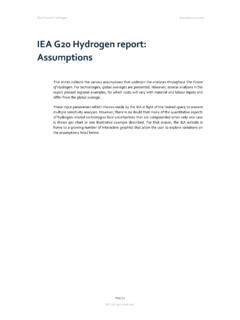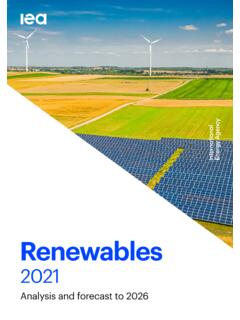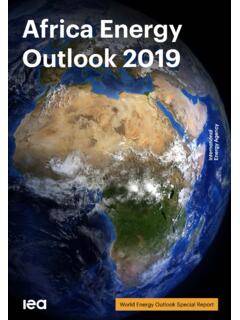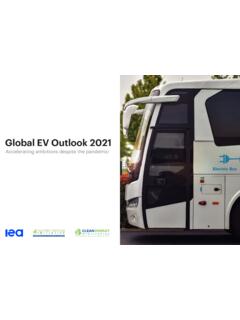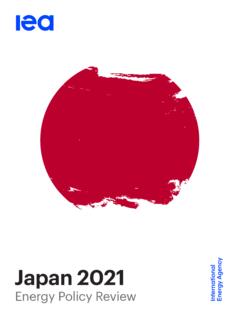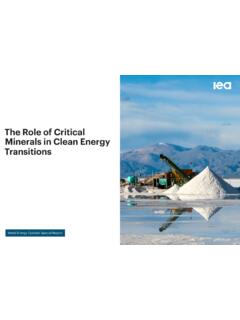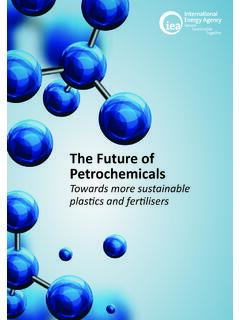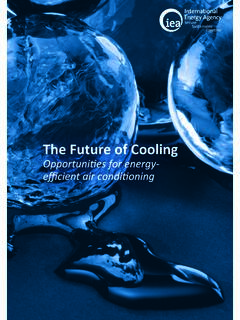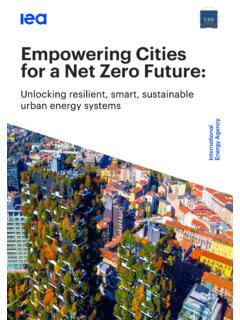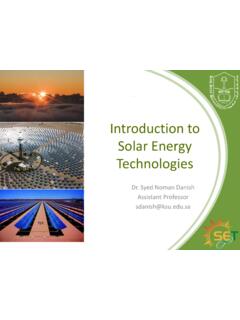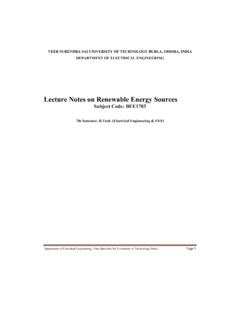Transcription of World Energy Investment 2021 - .NET Framework
1 World Energy Investment 2021 The IEA examines the full spectrum of Energy issues including oil, gas and coal supply and demand, renewable Energy technologies, electricity markets, Energy efficiency, access to Energy , demand side management and much more. Through its work, the IEA advocates policies that will enhance the reliability, affordability and sustainability of Energy in its 30 member countries, 8 association countries and note that this publication is subject to specific restrictions that limit its use and distribution. The terms and conditions are available online at publication and any map included herein are without prejudice to the status of or sovereignty over any territory, to the delimitation of international frontiers and boundaries and to the name of any territory, city or : IEA. All rights Energy Agency Website: member countries: Australia Austria BelgiumCanadaCzech Republic DenmarkEstoniaFinland France Germany Greece HungaryIreland ItalyJapanKorea Luxembourg Mexico Netherlands New Zealand NorwayPoland Portugal Slovak Republic Spain Sweden Switzerland Turkey United Kingdom United StatesThe European Commission also participates in the work of the IEAIEA association countries:BrazilChinaIndiaIndonesiaMoroc coSingaporeSouth AfricaThailandINTERNATIONAL ENERGYAGENCYW orld Energy Investment 2021 Abstract PAGE | 2 IEA.
2 All rights reserved. Abstract This year s edition of the World Energy Investment report presents the latest data and analysis of how Energy Investment flows are recovering from the shock of the Covid-19 pandemic, including full-year estimates of the outlook for 2021. It examines how investors are assessing risks and opportunities across all areas of fuel and electricity supply, efficiency and research and development, against a backdrop of a recovery in global Energy demand as well as strengthened pledges from governments and the private sector to address climate change. The report focuses on two key questions: Whether the growing momentum among governments and investors to accelerateclean Energy transitions is translating into an actual uptick in capital expenditureson clean Energy projects. Whether the Energy Investment response to the economic crisis caused by theCovid-19 pandemic will be broad-based or if some sectors, geographies andvulnerable parts of the World s population will be left Energy Investment 2021 Acknowledgement PAGE | 3 IEA.
3 All rights reserved. Acknowledgements, contributors and credits This report was prepared by the Energy Investment Unit in the Energy Supply and Investment Outlook (ESIO) Division of the Directorate of Sustainability, Technology and Outlooks (STO). Michael Waldron was the lead author and designed and directed the report with Tim Gould, Head of Division for Energy Supply and Investment Outlooks. Tanguy de Bienassis coordinated the report; he and Inchan Hwang authored the End-Use and Efficiency Section. Lucila Arboleya and Pablo Gonzalez authored the Electricity section. Tim Gould and Becky Schulz authored the Fuel Supply section; Pawel Olejarnik co-ordinated fossil-fuel supply modelling. Simon Bennett authored the R&D and Innovation and Hydrogen sections. Ryszard Pospiech co-ordinated modelling and data across sectors.
4 Eleni Tsoukala and Marie Fournier-S'Niehotta provided essential support. The report benefited greatly from contributions from other experts within the IEA: Carlos Fernandez Alvarez (coal), Adam Baylin-Stern (CCUS), Tae-Yoon Kim (refining and petrochemicals), Lilly Lee (Transport), Suzy Leprince (public R&D funding), Jean-Baptiste Le Marois (corporate R&D and venture capital), Ariane Millot (buidlings, renewables), Jeremy Moorhouse (biofuels), Yannick Monschauer (buildings efficiency), Leonardo Paoli (transport), Alison Pridmore (transport efficiency), Paul Hughes (industry), Hugo Salamanca (industry efficiency), Apostolos Petropolos (Transport), and Peter Zeniewski (LNG). The report is indebted to the high calibre of advice, data and support provided by other colleagues in the IEA, including Thibault Abergel, Heymi Bahar, Alessandro Blasi, Louis Chambeau, Davide D Ambrosio, Chiara Delmastro, Araceli Fernandez Pales, Marine Gorner, Ian Hamilton, Kevin Lane, Domenico Lattanzio, Jos Miguel Bermudez Menedez, Nikita Patil, Amalia Pizarro, Tess Sokol-Sachs.
5 The report also benefited from valuable inputs, comments and feedback from other experts within the IEA, including Mechthild W rsd rfer (Director of Sustainability, Technology and Outlooks), Keisuke Sadamori (Director of Energy Markets and Security), Laura Cozzi (Chief Energy Modeller), Laszlo Varro (Chief Economist), Peter Fraser, Timur G l, Tom Howes, Randi Kristiansen and Brian Motherway. Thanks also to Jad Mouawad, Astrid Dumond, Merve Erdem, Jethro Mullen, Rob Stone and Therese Walsh of the Communications and Digital Office. Erin Crum edited the manuscript. World Energy Investment 2021 Acknowledgement PAGE | 4 IEA. All rights reserved. Many experts from outside of the IEA provided input, commented on the underlying analytical work, and reviewed the report. Their coments and suggestions were of great value.
6 They include: Rigoberto Ariel Yepez-Garcia Inter-American Development Bank Manuel Baritaud European Investment Bank Thiago Barral EPE-Brazil Harmeet Bawa Hitachi ABB Power Grids Markus Becker GE Power Leila Benali Apicorp Kanika Chawla Sustainable Energy for All (SEforALL) Olivia Coldrey Sustainable Energy for All (SEforALL) Jonathan Coony World Bank Deirdre Cooper Ninety-One Adil Hanif European Bank for Reconstruction and Development (EBRD) David Hart Information Technology and Innovation Foundation Donald Perry Kanak Prudential Plc Lahra Liberti Organisation for Economic Co operation and Development (OECD) Delphine Marchi International Finance Corporation (IFC) Espen Mehlum World Economic Forum Valerio Micale Climate Policy Initiative Baysa Naran Climate Policy Initiative Richard Norris Pandreco Ltd Ignacio Perez Arriaga Massachusetts Institute of Technology Andrea Pescatori International Monetary Fund (IMF) Davide Puglielli Enel Lazeena Rahman International Finance Corporation (IFC) Justine Roche World Economic Forum (WEF) World Energy Investment 2021 Acknowledgement PAGE | 5 IEA.
7 All rights reserved. Gagan Sidhu CEEW Centre for Energy Finance Gurdeep Singh NTPC Limited Maria-Antonietta Solinas Eni Sandhya Srinivasan World Bank Jessica Stephens Africa Minigrids Developers Association Cecilia Tam Organisation for Economic Co operation and Development (OECD) Wim Thomas Independent Akhilesh Tilotia National Investment and Infrastructure Fund (NIIF) David Victor UC San Diego Merte Villum Pedersen UNEP DTU Partnership Andrew Walker Cheniere Marketing Ltd. Kelvin Wong DBS Bank Peter Wood Royal Dutch Shell The work could not have been achieved without the support and co-operation provided by many government bodies, organisations and companies worldwide, notably: European Commission and European Union's Horizon 2020 research and innovation programme funding under grant agreement No 952363; Ministry of Economy, Trade and Industry, Japan; Ministry of Foreign Affairs, Japan; and Ministry of Economic Affairs and Climate Policy, Netherlands.
8 This publication has been produced with the financial assistance of the European Union as part of the Clean Energy Transitions in Emerging Economies programme. The Clean Energy Transitions in Emerging Economies programme has received funding from the European Union s Horizon 2020 research and innovation programme under grant agreement No 952363. This publication reflects the views of the IEA Secretariat but does not necessarily reflect those of individual IEA member countries or the European Union (EU). Neither the IEA nor the EU make any representation or warranty, express or implied, in respect to the publication s contents (including its completeness or accuracy) and shall not be responsible for any use of, or reliance on, the Energy Investment 2021 Executiive summary PAGE | 6 IEA.
9 All rights reserved. Executive summary Global Energy Investment is set to rebound by around 10% in 2021, reversing most of the drop caused by the pandemic In 2021, annual global Energy Investment is set to r ise to USD trillion, rebounding nearly 10% from 2020 and bringing the total volume of Investment back towards pre-crisis levels. However, the composition has shifted towards power and end-use sectors and away from traditional fuel production. Prospects for Investment have improved markedly along with economic growth, although there are significant country-by-country variations. Global Energy demand is set to increase by in 2021, more than offsetting the 4% contraction in 2020, according to the latest IEA estimates. While many Energy companies remain in a fragile financial state, there are signs developers are using the window provided by accommodative monetary policy and government backing to plan infrastructure developments and investments in new projects.
10 Global Energy Investment , 2017-2021 IEA. All rights reserved. Notes: Energy infrastructure includes midstream and downstream oil and gas infrastructure, electricity networks and batteries. Investment is measured as the ongoing capital spending in Energy supply capacity (fuel production, power generation and Energy infrastructure) and Energy end-use and efficiency sectors (buildings, transport and industry). The scope and methodology for tracking Energy investments is available in the methodology document. 5001 0001 5002 0002 50020172018201920202021 EBillion USD (2019)BuildingsTransportIndustryEnergyin frastructurePower generationFuel productionWorld Energy Investment 2021 Executiive summary PAGE | 7 IEA. All rights reserved. The anticipated upswing in investments in 2021 is a mixture of a cyclical response to recovery and a structural shift in capital flows towards cleaner technologies.
